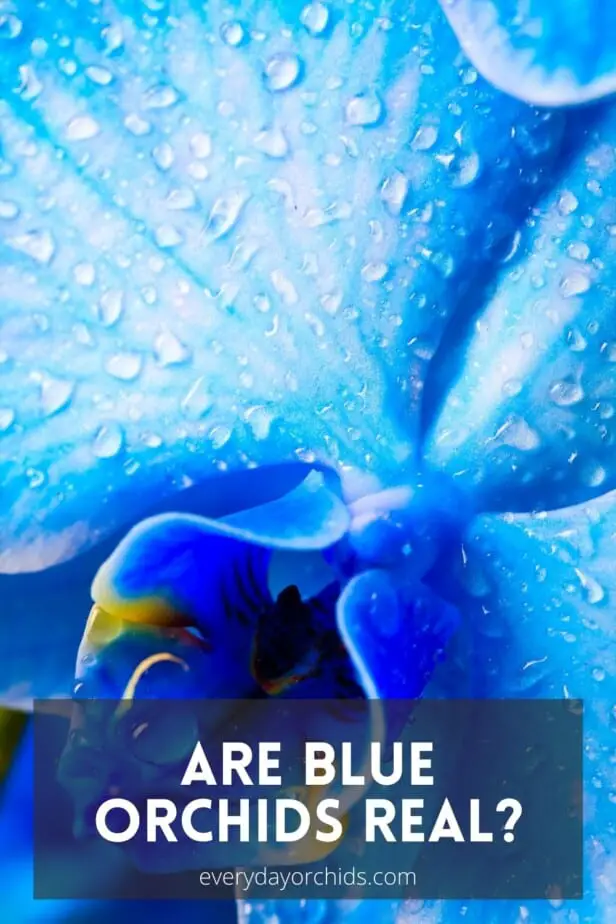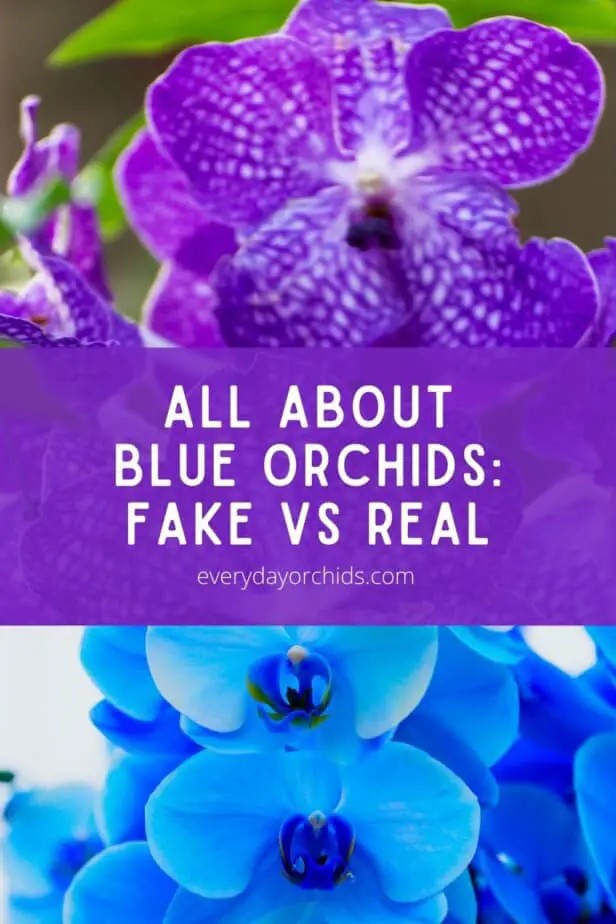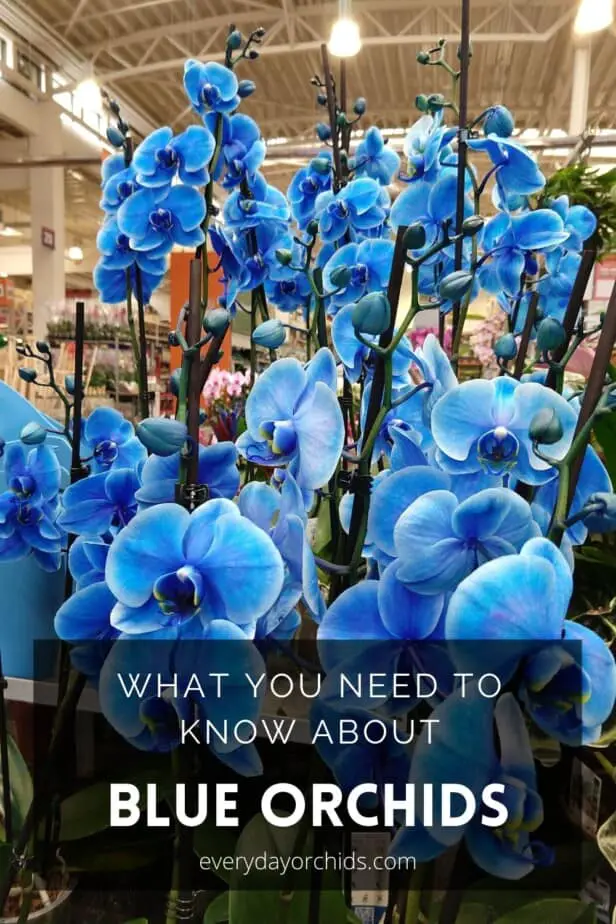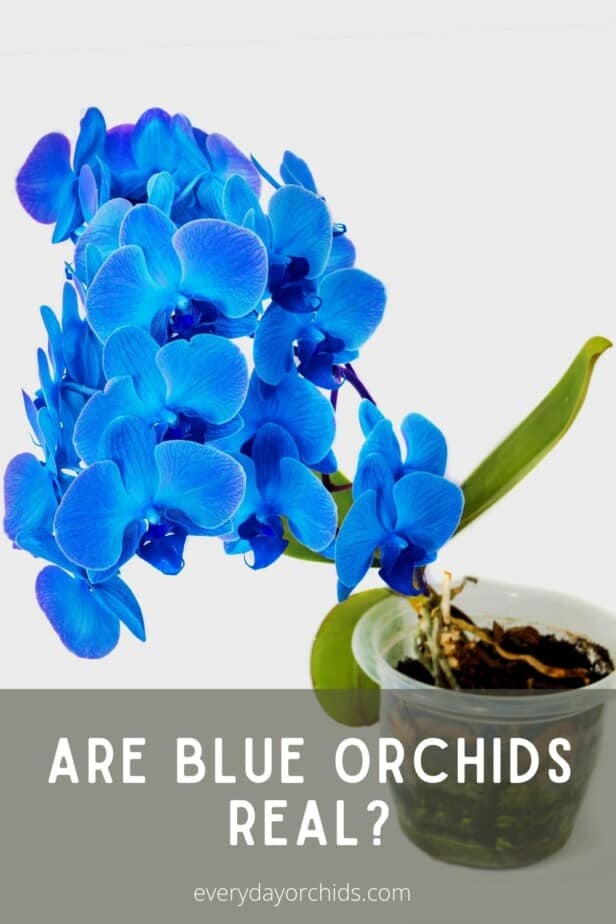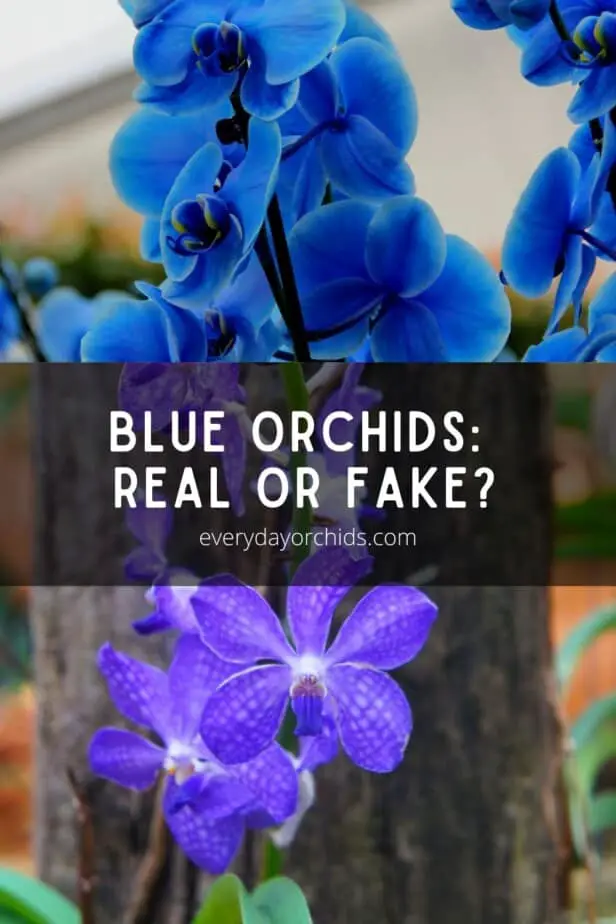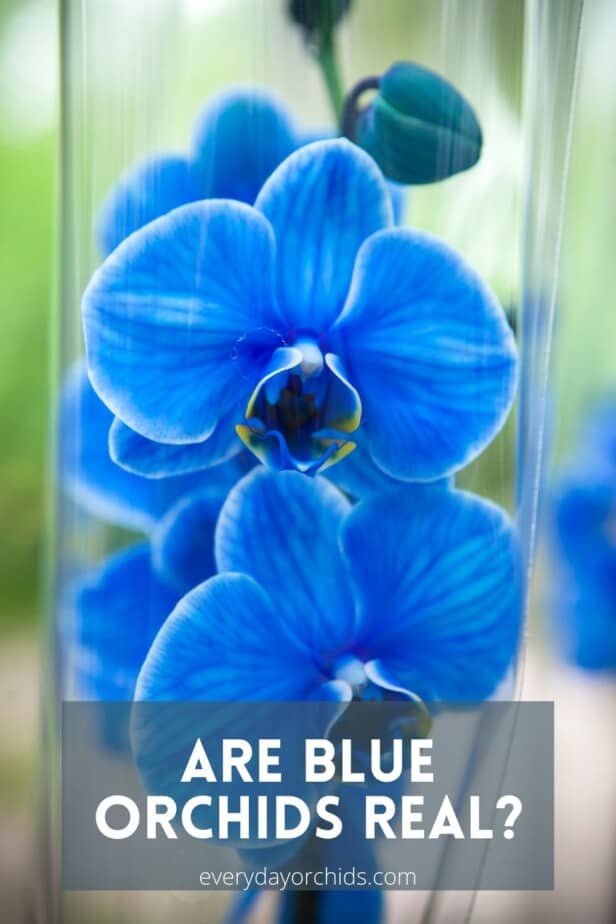Have you ever come across a vibrant, deep blue-colored orchid and wondered if it was real? These gorgeous deep blue Phalaenopsis orchids are often for sale at the local flower shop or grocery store. Those blue orchid flowers are so vibrant in color that they look artificial. Surely, nature couldn’t have created these blue orchid blooms, right? Right.
Most blue orchid blooms are artificially created by orchid growers and are not real. Orchid growers inject blue dye into the orchid’s flower spike as it grows. White Phalaenopsis orchids are typically used for this. Depending on the stage of growth the flower spike is in, the orchid blooms will be varying shades of blue. That said, there are some blue orchids that occur naturally, such as blue Vandas.
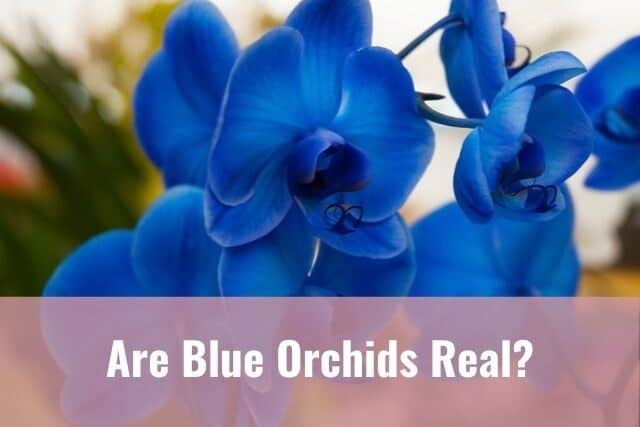
Are you interested in learning more about blue orchids and how they are made? I’ll teach you how professional growers create blue orchids and how you can do this too. I’ll also tell you about some naturally occurring blue orchid varieties and where you can find them. Keep reading to learn more.
Please note that these links are affiliate links and as an Amazon Associate, I earn from qualifying purchases. Purchases made through affiliate links in this post may generate commissions at no additional cost to you. Use this link for a discounted Amazon Prime trial. Thank you for your support!
Table of Contents
How Do Orchid Growers Make Blue Orchid Flowers?
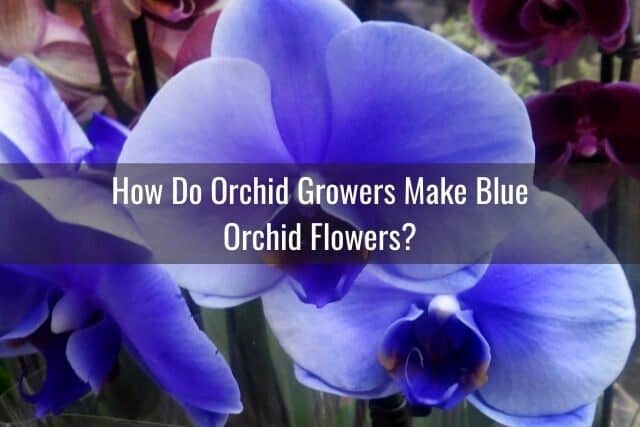
Sadly, the majority of blue orchids being sold are not naturally blue. Orchid growers have many tricks up their sleeves to sell more flowers, including making orchids bloom on a certain schedule and grow multiple spikes.
One trick is to dye orchid flowers different colors. This creates eye-catching orchid displays and entices customers to buy these unique orchids.
To make blue orchids, orchid growers usually use a white orchid with an established flower spike. Technically, any color orchid can be used, but white allows the blue pigment to show the best.
How To Create Blue Orchids
First, orchid sellers make a small hole in the orchid’s flower spike or stem somewhere below the flower buds or blooms.
Using a small-gauge needle and syringe filled with blue dye, they inject blue dye into that hole. As water and nutrients travel along the orchid stem to the end of the flower spike, the blue dye will travel along that same pathway and color the orchid flowers blue.
After the blue dye is injected into the orchid spike, the hole is sealed with wax. This prevents the blue dye from leaking back out onto the orchid stem and making a mess.
The timing of when the dye is injected is important. To create light blue or pastel blue orchid blooms, growers inject the blue dye before the flower buds open. To create that vibrant bright or deep blue color, orchid growers inject blue dye into the orchid spike when the blooms are opening or are fully open.
After the dye has been injected, it usually takes at least 24 hours for the orchid blooms to change color.
Oftentimes, the blue orchids you see will be Phalaenopsis orchids. However, Dendrobiums, Cymbidiums, and many other orchid varieties can also be dyed blue.
Potential Problems With Blue Orchids
There are a few problems you may run into when buying artificially colored orchids. These issues are mainly related to improper technique or use of excessive amounts of dye.
Leaking Dye
If the orchid grower fails to use wax to seal up the injection site, you may find blue dye leaking out of the hole. This can get very messy, as blue dye stains. It is hard to wash off if it gets on clothing and furniture.
If you are buying a dyed orchid, inspect it carefully. Make sure any injection sites have been sealed up with wax.
Too Much Dye
If the orchid grower injects the orchid spike with too much dye, it is possible that the dye overload could be toxic for the orchid. The orchid may try to expel the excess dye itself. You will see this when blue dye seeps through the nodes or other porous areas of the orchid.
Sometimes orchids will drop their leaves, and the ends of the leaves themselves have a blue tinge. This is another sign that too much blue dye was used.
What To Do If Your Blue Orchid Is Leaking Dye or Dying
If you notice this happening and want to save your orchid, there are several things you can do.
Trim The Orchid Spike
First, trim off the orchid spike with the dyed flowers. If there is blue dye seeping from the nodes, you may want to wear disposable gloves so the dye doesn’t stain your hands.
You can put these cut orchid stems in a vase and continue to enjoy the blooms. Removing the spike will help take a good portion of the blue dye out of circulation.
Cover the area where you cut off the orchid spike with ground cinnamon to help dry it up and prevent infection. You can read more about the benefits of using ground cinnamon on orchids here.
Place Charcoal In The Potting Media
If your orchid is also dropping leaves, you can use charcoal in the potting medium to further draw out any toxins from the blue dye. Good quality charcoal can help remove impurities and extend the life of your potting medium.
Repot Your Orchid
For an orchid that struggling to stay alive, you can try repotting your orchid in new potting medium and use a higher percentage of charcoal in the mix. You may have to buy horticultural charcoal separately and add some to the orchid potting medium yourself.
When The Orchid Reblooms, Will The Flowers Be Blue?
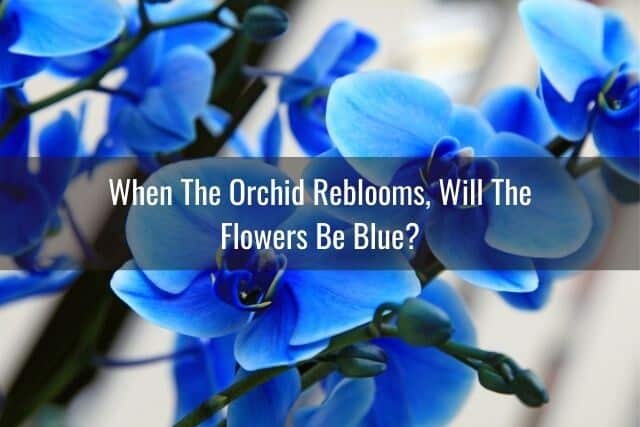
Unfortunately, no. The blue orchid flowers will only be present for one blooming cycle. When the orchid reblooms, the next batch of flowers will be white or whatever color they were before they were dyed. If you were thinking the orchid would rebloom with blue flowers, the white flowers may come as a surprise or disappointment to you.
Oftentimes, white Phalaenopsis orchids are used to artificially create blue orchid blooms. White flowers allow more of the artificial coloring to saturate the bloom. The blue color is only present because blue dye was injected into the orchid flower spike.
After the blooming cycle ends, the orchid spike will inevitably wither, die and be pruned off. The blue dye that was injected into that flower spike will have dried up and be lost when the dead orchid spike is pruned off.
How to Create Blue-Colored Flowers At Home
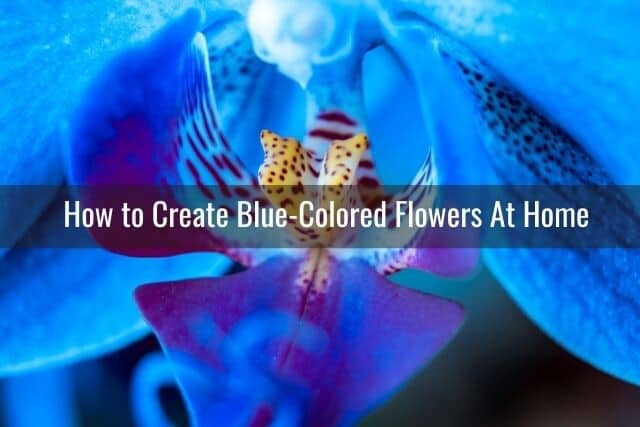
So far, I’ve talked about how professional flower growers create blue orchids. But did you know that you can do this too? Yes, you can dye your own flowers at home.
Dyeing flowers is actually a fun project to do with kids. They’ll learn about science and capillary action while having fun watching the white flower petals change colors. Best of all, you don’t need to have a needle, syringe, or wax. You’ll use cut white flowers and food coloring, making the process very straightforward.
Cut orchid stems can last for weeks, allowing you to enjoy your colored orchid blooms for a long time. By doing a few simple things, you can extend the life of your cut orchid stems even longer.
How to Dye Your Own Flowers
To dye your own flower blooms, you will need the following:
- Cut flower stems with open blooms
- Vase
- Food coloring
- Water
For this project, use white flowers for best results. You can use white orchids, carnations, daisies, tulips or any other white flower. You can even try different flower varieties and see which type of flower absorbs the color the best and holds the color the longest.
To start, prepare your vase with water and add in the food coloring of choice. You will need anywhere from 20-30 drops of food coloring per half cup of water. Mix well.
For best results, use slightly warm water rather than cold water. Cut flower stems take up warm water or room temperature water more easily than cold water.
Slant cut your orchid stems. Place the freshly cut orchid stems in the vase of colored water. Wait a few hours to a day to see the effect. After a few hours, the flower petals may start to change color.
How Long Will It Take For The Flowers to Change Color?
It may take at least a day for the orchid blooms to take on a different hue. Color changes will appear first in the outermost edges of the petals.
Leave the orchid flowers in the colored water longer for a more pronounced, deeper color. The speed at which the orchid blooms change colors depends on how fast the cut stems absorb the colored water.
You may need to leave the stems in the colored water longer than a few hours. You can safely leave the cut stems in the colored water overnight.
Be aware that once you switch the cut flower stems to a vase with plain, non-colored water, those stems will start to “drink” or absorb the plain water. Over time, this will change the artificial coloring of the flower, trending back towards the natural color of the bloom.
How to Make Multi-Colored Blooms
Making multi-colored flowers at home is also possible. This is another fun project to do with kids. You can make it an educational experience by having the kids learn about capillary action and how plants uptake water.
To make multi-colored flowers, you will want to follow the same method outlined above for dyeing flowers with one additional step.
Before placing your cut flower stems in the colored water, slice the stem vertically partway up the middle to create two equal halves. Place one side of the slit stem in a cup of colored water. Place the other side of the slit stem in another cup filled with different colored water.
Let the two sides of the cut flower stem sit in the two different cups of water and observe the petals change color over the next few hours. The longer you leave the cut stem in colored water, the deeper and more pronounced the colors will be.
Some flowers, such as carnations and daisies may show this color change faster than other flowers, such as orchids, which may take at least a day or more to have a color change.
You can also try this with three or four slits in the flower stem and use three or four different colors for more variation. Doing so can create a rainbow or tie-dye effect in your flowers.
If you prefer not to slit your orchid stem up the middle, you can also try placing it in a vase filled with colored water for several hours or overnight. After the flowers have changed color, you can then place it in another vase filled with different colored water.
As this new colored water slowly gets absorbed by the orchid stem, the flowers will also slowly take on the second color. You can see the first color on the outer edges of the flower petals while the newer, second color will be towards the center of the flower.
What is the Meaning or Significance of Blue Orchids?
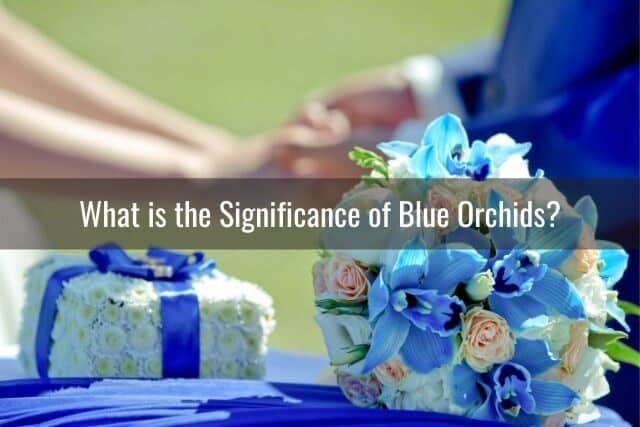
In traditional feng shui belief, orchids symbolize fertility, new beginnings, purity, perfection, beauty and love. Blue is a calming color, encouraging reflection, strength and peace. You can use colored orchids to improve feng shui in your home.
Blue orchids are a symbol of strength and peace. True blue orchids, that is, those occurring naturally, are rare.
Many people enjoy blue orchids for their beauty and uniqueness. Some brides like to incorporate blue orchids into their wedding decor and bouquets for that unexpected pop of color on their special day.
Are There Any Naturally Occurring Blue Orchids?
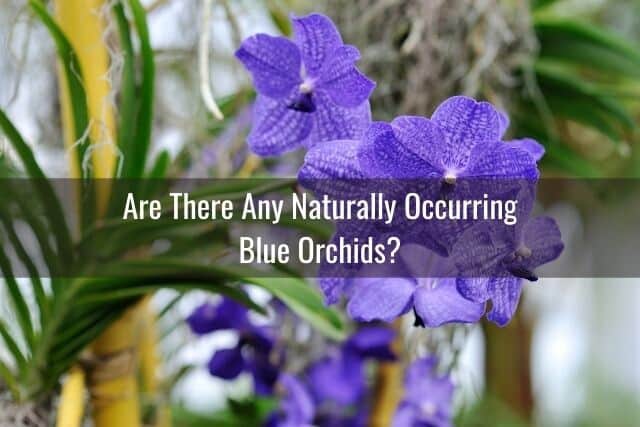
Yes, there are a few species of orchids that occur naturally and have blue-colored flowers. Unfortunately, these species do not include the blue Phalaenopsis orchids that you commonly see for sale in the local flower shop or grocery store.
Truly blue orchids that are naturally occurring are rare. Naturally occurring blue orchids include blue Vandas, Pescatoria coelestis orchids, and Thelymitra crinita orchids. I will briefly go over each of these orchids below.
Blue Vanda Coerulea Orchids
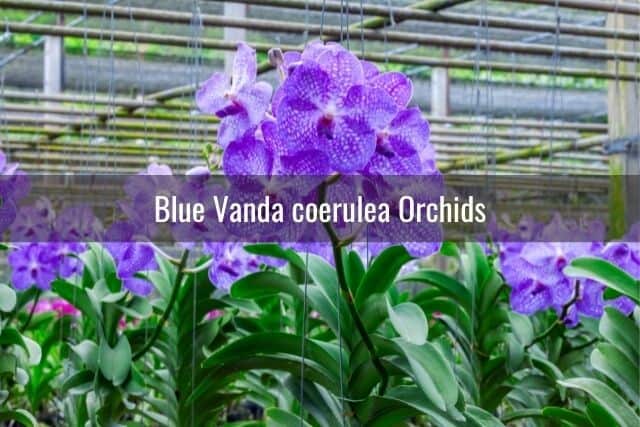
Vanda coerulea orchids are also known as the “Blue Orchid” or “Blue Vanda.” This species of orchid is found in northeast India and southern China.
These are epiphyte orchids that grow on the rough bark of trees. Each orchid plant can produce twenty to thirty flower spikes, and each spike has multiple blue-purple flowers on it.
One of the prettiest blue Vanda coerulea varieties is the Vanda coerulea supra. This is also called Lord Rothschild’s Variety. The blooms are a rich indigo, purple or blueish-purple color. While no Vanda is a “true blue,” some of these flowers do come close.
Fun fact: The “juice” of the Vanda coerulea orchid has some medicinal purposes. The liquid from the flowers is used as an ingredient in eye drops for treating glaucoma and cataracts. In addition, properties of the Vanda coerulea flower are known to be used in anti-aging treatments.
Blue Vanda Coerulescens Orchids
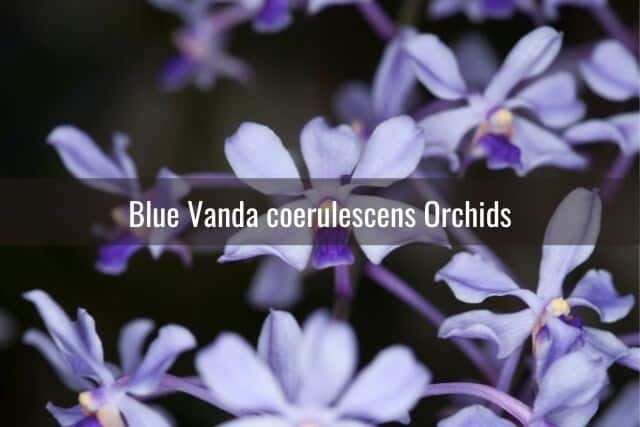
Vanda coerulescens orchids are part of the Vanda genus of orchids. Another name for these orchids is “The Shy Blue Vanda.” These orchids prefer moderate to high light and warm temperatures. They are found in the forests of India, the eastern Himalayas, China, Thailand, and Myanamar.
Vanda coerulescens orchids naturally come in shades of blue or pink. If you are lucky enough to get a blue Vanda coerulescens, you will find that each flower spike holds multiple flowers that are light bluish purple with a darker blue lip. The blue flowers are due to a recessive color gene. Pink is actually the dominant color gene for this orchid species.
That said, if you are wanting to buy a blue Vanda coerulescens, make sure you buy one already in bloom. That way, you will know for sure you are buying a blue Vanda. Otherwise, you won’t be able to tell what color the blooms will be until the next blooming season, and there is a chance they could be pink. These orchids typically bloom in the late winter or spring.
Vandas have long roots, so will do best grown in hanging baskets or mounted to trees. These growing conditions allow the roots to grow and really spread out.
In addition to routine watering, you will need to regularly mist the Vanda roots so they do not dry out. When deciding what kind of potting media to use for your Vanda coerulescens, choose a medium that is coarse and well-draining.
You can read more about how to care for a Vanda orchid here.
Pescatoria Coelestis Orchids
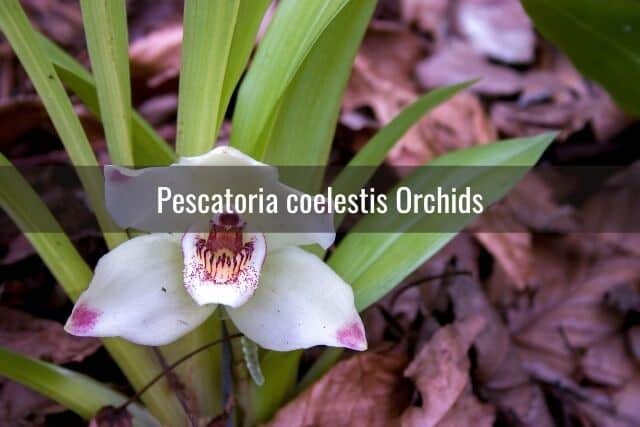
Another naturally occurring blue orchid is the Pescatoria coelestis. This is an orchid species that is part of the genus Pescatoria. Pescatoria coelestis orchids are also called “The Sky-Blue Pescatoria,” Bollea coelestis, or Zygopetalum coeleste orchids.
These orchids grow in the forests of Ecuador and Columbia. Pescatoria coelestis orchids are terrestrial orchids. The low-lying clouds and fog in the forests provides the humidity that these orchids need to grow.
The flowers of the Pescatoria coelestis orchids range in color from blue to purple. Each flower spike contains only one flower which lasts for an extended period of time. These orchids grow best in partial shade similar to their natural conditions in the forest.
Thelymitra Crinita Orchids
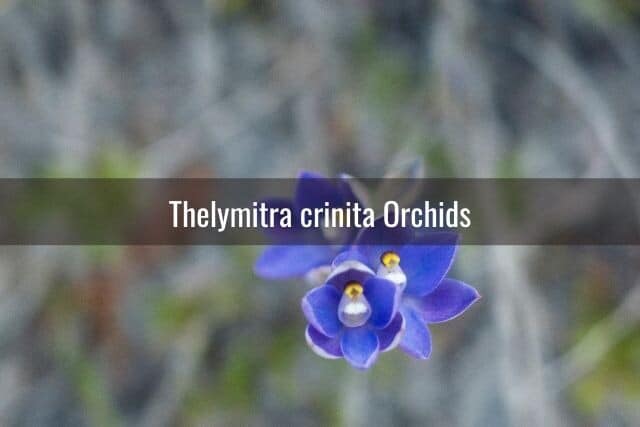
I saved this beautiful orchid for last. The Thelymitra crinita orchid is the only truly blue orchid out there. The other orchids mentioned above are blueish-purple, blue-indigo, or light blue, but the Thelymitra crinita orchid is a brilliant blue color.
This orchid also goes by “Blue Lady Orchid,” “Queen Orchid,” or the “Lily Orchid.” It is part of the Thelymitra genus of orchids.
The Thelymitra crinita orchid is a terrestrial orchid. It grows in the coastal forests and woodlands of Southwestern Australia. Each orchid flower spike has anywhere from two to fifteen 1 to 2-inch sized flowers. The flowers range from light blue to brilliant bright blue to a deep dark blue color.
Some people call this the “sun orchid,” since the flowers will only fully open on warm, sunny days. Insects pollinate this orchid, and the blooming season lasts from September to November.
Where Can You Buy Blue Orchids?
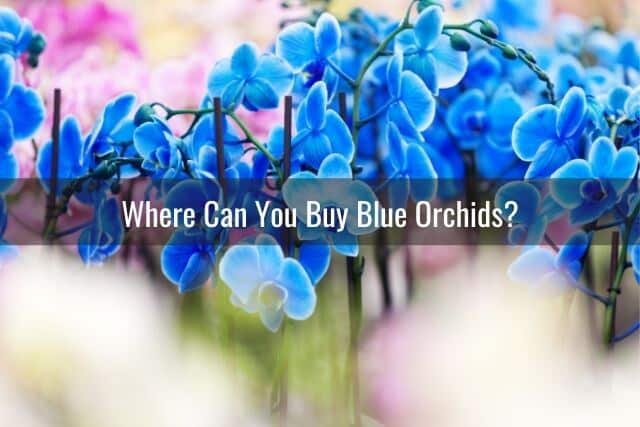
Many places sell artificially colored blue Phalaenopsis orchids, including most grocery stores and flower shops. I have personally seen blue Phalaenopsis orchids, along with other artificially colored orchids, at Safeway and Whole Foods, and at flower shops.
If you want to buy a naturally occurring blue orchid, such as a Vanda Coerulea, you will have to look online. OrchidWeb is an online seller of many orchid varieties, including the Vanda coerulea supra that I mentioned above. OrchidPeople is another online orchid seller. Please note that these are not affiliate links. I am not associated with these sellers and do not profit if you buy from them.
Are Blue Orchids Expensive?
Blue Phalaenopsis orchids tend to be priced higher than their naturally colored counterparts, partially due to the extra work that goes into dyeing the flowers.
For example, Home Depot is selling this 5-inch potted blue Phalaenopsis for $50 at the time of this writing. An online retailer called 1-800 Flowers is selling a double-stemmed blue orchid for $125. They are also selling 20 stems of dyed Dendrobium stems with a vase for $110. Prices are, of course, at the time of this writing. Again, I am not affiliated with these retailers. I am merely providing the links in case you have doubts about the outrageous prices.
In comparison, you can easily find a double-stemmed Phalaenopsis orchid at Trader Joe’s or Whole Foods (big box retailers) for under $25. The mark-up for blue orchids can be explained by their uniqueness and the effort that has to go into dyeing the flowers.
Final Thoughts
Many of the blue orchids you will come across are not true blue orchids that occur naturally. If you buy a blue Phalaenopsis orchid, or are gifted one, don’t be surprised if the next blooming season only yields white flowers. The artificial coloring that produces those beautiful bright blue flowers only lasts for one flowering season.
Instead, if you are looking for a unique and unusual orchid that is naturally blue, look for a blue Vanda, a Pescatoria coelestis orchid, or a Thelymitra crinita orchid. These orchids may be harder to find and may require the care of a more experienced orchid grower, but their beautiful blooms year after year may be worth the effort.
If you enjoyed this article, please pin it and share!
